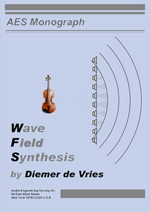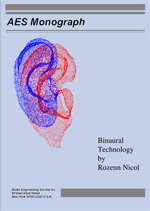An AES monograph is a work of writing upon a single audio-related subject and is usually written by a single author.

In December 1988, Delft University professor Guus Berkhout published his article in the AES Journal in which he proposed the concept of Wave Field Synthesis (WFS) as a format for spatial sound reproduction without ‘sweet spot’ limitations. Now, more than twenty years later, Diemer de Vries who was involved in the development and application of the concept from the very beginning, presents a 93-page monograph on the theme.
The principles of WFS are explained once again, with a digestible summary of the underlying mathematics. An explanation is also given of how the necessary steps, from theory (where things are infinitely large or small, having ideal properties) to real-world application, have successfully been made by making ample use of the properties of the human hearing mechanism.
Reproduction in WFS is most effective when dedicated recording techniques are used. A survey of such techniques is given. Special attention is given to the EU-project “CARROUSO” where ten institutes successfully cooperated on WFS-oriented research and development. Due to the results of this project, WFS is now known and recognized worldwide.
An illustrated short description is given of all - as far as known to the author - existing WFS systems in the world. Applications range from high-level audio research via multimedia education to night club entertainment. The monograph ends with a view to the future.

Rozenn Nicol has been investigating Spatial Audio technology at Orange Labs for more than ten years. With the publication of this monograph, she aims to promote a better understanding of how binaural technology really "works". Despite its straightforwardness the reproduction of binaural audio with headphones is always impressive - a really convincing 3D sound scene is achieved. This is possible because binaural technology merely mimics the spatial encoding that we use daily when we localize sounds in real life.
Starting from practical issues, concerning what is the real meaning of sound recording and rendering for binaural technology, the underlying theory is then progressively examined. The diffraction of the acoustic wave by the listener's body defines the key concept of binaural technology and can be represented by the associated transfer functions, which are known as Head Related Transfer Functions (HRTF). HRTFs are therefore the raw material of binaural spatialization. It is shown how the spatial information is conveyed through HRTFs, investigating both physical phenomena and auditory localization mechanisms.
Special attention is given to binaural synthesis which consists in simulating the left and right signals as they would have been recorded by a pair of microphones inserted in the listener's ear. This is one of the most well known applications of binaural technology, since it allows one, to create with full control a virtual auditory space for psychoacoustic experiment or virtual reality purposes. by straightforward filtering.
Although binaural technology is a powerful tool for sound spatialization, it should be kept in mind that, as the spatialization is determined by the listener's morphology which is unfortunately strongly individual, the spatial encoding of a sound scene is theoretically valid for one sole individual. The monograph ends with an overview of solutions for adapting the binaural spatialization process to an individual’s variability.
